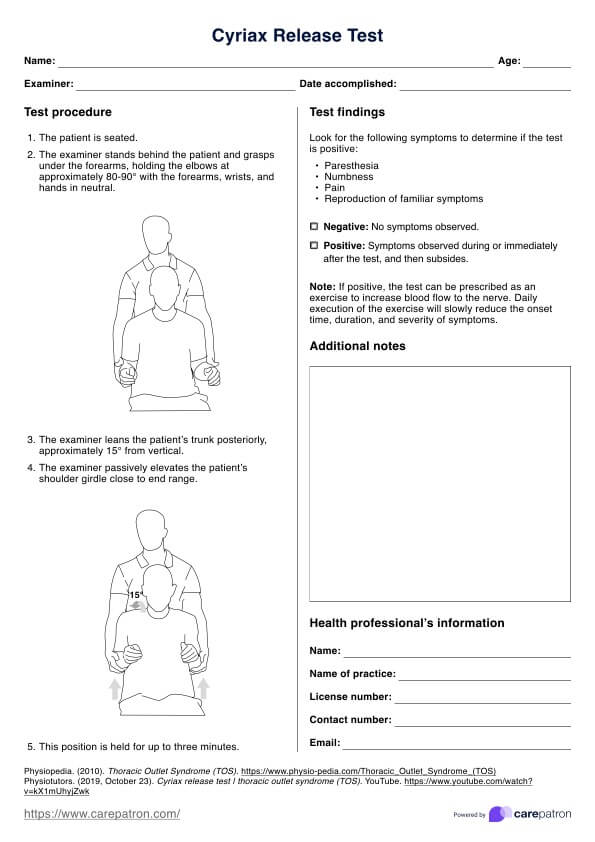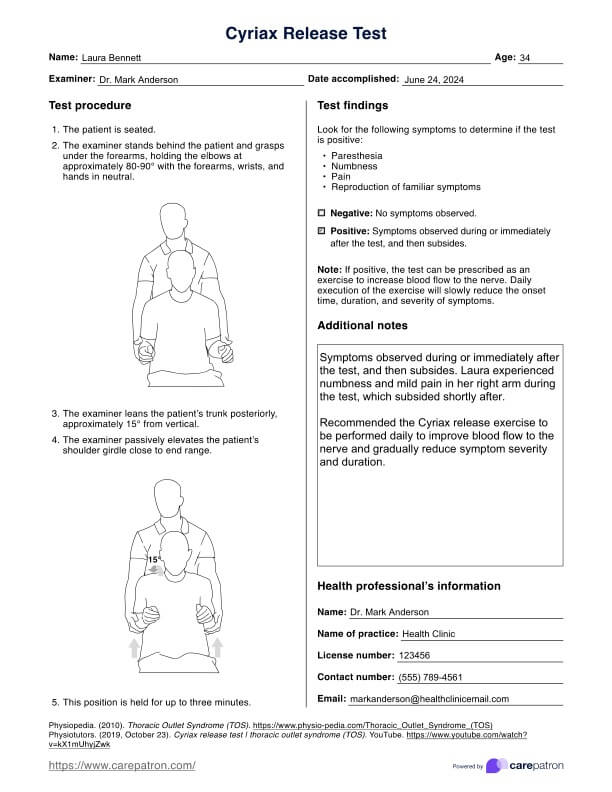Cyriax Release Test
Learn about the Cyriax Release Test for diagnosing thoracic outlet syndrome. Understand its purpose and procedure with our guide and free template.


What is thoracic outlet syndrome?
Thoracic outlet syndrome (TOS) is a group of disorders that occur when blood vessels or nerves in the thoracic outlet—the space between your collarbone and first rib—are compressed. These outlets supply the upper extremity. Compression of these outlets, which may involve the cervical spine, can lead to pain in your shoulders and neck and numbness in your fingers. The condition is named for the thoracic outlet, which is the area between your ribcage and collarbone.
There are three types of TOS: neurogenic, venous, and arterial, with neurogenic TOS being the most common. Neurogenic thoracic outlet syndrome affects the brachial plexus, a network of nerves that sends signals from your spinal cord to your shoulder, arm, and hand. Venous TOS affects the veins, and arterial TOS affects the arteries, including the subclavian artery.
Common causes of TOS include anatomical defects, poor posture, trauma, repetitive activity, and carrying heavy items. Symptoms vary depending on the type of TOS but often include neck and shoulder pain, finger numbness or tingling, arm weakness, and a feeling of heavy arms or hands.
How to assess thoracic outlet syndrome
Assessing TOS involves a comprehensive evaluation that includes observation, palpation, neurological screening, and special tests to confirm the diagnosis.
During observation, look for postural abnormalities such as rounded shoulders or a forward head position. Check for signs of poor blood flow, including cyanosis, swelling, and unusual paleness in the arms or hands. Also, note any muscle wasting, particularly in the hand or arm.
For palpation, feel for any temperature differences between the limbs. Check for tenderness in the supraclavicular fossa, scalene muscles, and trapezius muscle. These areas are commonly affected in TOS.
The neurological screening involves manual muscle testing (MMT) and assessing the flexibility of several muscles, including the anterior and middle scalenes, pectoralis major and minor, levator scapulae, sternocleidomastoid, and serratus anterior.
Special tests are crucial in diagnosing TOS. These include the elevated arm stress test (roos test), Wright’s Test, Adson's Test, Cyriax Release Test, supraclavicular pressure test, costoclavicular maneuver, upper limb tension test, and cervical rotation lateral flexion test. Each test helps identify the presence and severity of TOS, providing a comprehensive understanding of the patient's condition to guide appropriate treatment.
Cyriax Release Test Template
Cyriax Release Test Example
What is the Cyriax Release Test?
The Cyriax Release Test is a diagnostic procedure used to identify TOS by alleviating compression on the neurovascular bundle in the brachial plexus, which is affected by the anterior and middle scalene muscles. This test differentiates itself from other special tests due to its focus on passive shoulder girdle elevation.
A unique aspect of the Cyriax Release Test is its use as both a diagnostic tool and a therapeutic exercise. By performing passive shoulder girdle elevation, the test can restore neural blood flow and normalize function, leading to a temporary relief of symptoms. This release phenomenon occurs due to the decompression of nerve trunks or cords, which can cause the spontaneous firing of sensory fibers. Common symptoms observed during a positive test include paresthesia, numbness, and pain.
How to perform the Cyriax Release Test
To accurately perform the Cyriax Release Test, follow these steps to ensure proper technique and reliable results:
Step 1: Access the template
Start by accessing the Cyriax Release Test template on the Carepatron app. This will provide you with a structured format to record patient information, a set of procedure steps to follow, and how to interpret test findings. You can edit the template on the app, too.
Step 2: Positioning and execution
Have the patient seated comfortably on a chair. Ensure they are relaxed and their hips and knees are flexed to 90 degrees. Stand behind the patient and grasp under their forearms, holding the elbows at approximately 80-90° with the forearms, wrists, and hands in a neutral position. Lean the patient’s trunk posteriorly, approximately 15° from vertical. Then, passively elevate the patient’s shoulder girdle close to the end range. This position should be held for up to three minutes.
Step 3: Observe and record findings
Throughout the procedure, observe the patient for any symptoms such as paresthesia, numbness, pain, or reproduction of familiar symptoms. After completing the test, document the results on the template, noting whether the test was positive or negative based on the presence or absence of symptoms.
Results and interpretations of the Cyriax release maneuver
A test is considered negative if the patient does not experience any peripheral symptoms during or immediately after the test. This indicates that there is no significant compression of the neurovascular bundle in the thoracic outlet.
On the other hand, a test is considered positive if the patient experiences symptoms such as paresthesia, numbness, pain, or a reproduction of their familiar symptoms during or immediately after the test. These symptoms indicate a release phenomenon, where the decompression of the neurovascular bundle of the brachial plexus restores neural blood flow and function. After a positive test, you can also provide guidance on how to perform the exercise daily to improve neural blood flow and reduce symptom severity over time.
Treatment of thoracic outlet syndrome
Treating thoracic outlet compression involves a range of approaches depending on the severity and specific cause of the condition. Here are some common treatments:
- Physical therapy: Aimed at strengthening and stretching the shoulder muscles to improve posture and induce thoracic outlet decompression. Exercises may include scalene stretches, pectoral stretches, and shoulder blade squeezes.
- Pain management: Includes medications such as nonsteroidal anti-inflammatory drugs, muscle relaxants, and pain relievers to manage discomfort and reduce inflammation.
- Postural adjustments: Training patients to adopt better posture, both during activities and at rest, to minimize strain on the thoracic outlet. This can involve ergonomic adjustments in the workplace or during daily activities.
- Surgical treatment: In severe cases where conservative treatments fail, thoracic outlet syndrome surgery might be necessary to relieve the compression. Procedures may involve removing a portion of the first rib (rib resection), removing scar tissue development, or releasing tight muscles that contribute to the compression.
- Lifestyle modifications: Advising patients on changes that can alleviate symptoms, such as weight loss, avoiding heavy lifting, and taking regular breaks from repetitive activities that may exacerbate the condition.
These treatments aim to alleviate symptoms, improve functionality, and prevent further complications associated with thoracic outlet syndrome.
Commonly asked questions
The best test to assess thoracic outlet syndrome varies by individual case, but common tests include the Cyriax Release Test, Wright’s Test, and the Elevated Arm Stress Test (Roos Test).
The sensitivity of the Cyriax Release Test has not been definitively established, but it has a specificity of 97.4% when held for 1 minute and 87.8% at 3 minutes.
The Cyriax rule refers to the diagnostic principle that if pain is relieved by a particular motion or position, it likely indicates a mechanical cause, guiding the therapeutic approach.







































































































